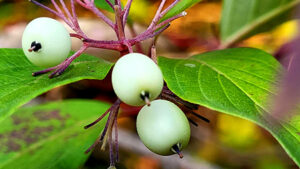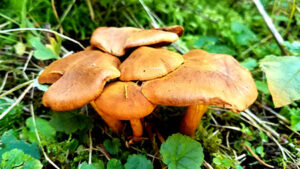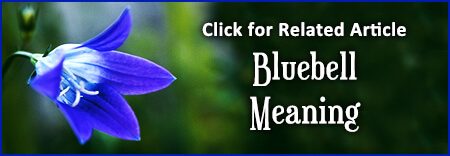
Nature Symbols & Spiritual Meaning
In many cultures, nature symbols are endowed with religious and philosophical meaning. For example, mountains are often symbols or strength, endurance and spirituality. Water symbolizes the source of life and the highest good. Rocks represent safety, protection, and refuge. Nature symbolism is highly developed in specific cultures such as Chinese landscape painting.
Table of Contents
Share this page with a friend!
Nature Symbols in Interior Design
Some cultures have also developed elaborate systems for creating optimal interior environments using nature symbols. The Egyptians painted murals of nature in hospitals, usually with blue ceilings to represent the sky and green floors to symbolize the earth. Another recognized system for optimal interiors is Vastu, the Hindu science of architecture and interior design. A popular system adopted in the West is known as feng shui.
Nature Symbols and Human Wellness
Nature symbols have powerful impacts on the human psyche and wellness. In fact, artwork featuring images of nature has been proven in scientific studies to foster stress recovery. Viewing nature elicits positive responses in blood pressure and muscle tension. A visual connection to nature lowers heart rates and assists in emotional and psychological wellness. In this way, nature symbols create comforting and peaceful interiors for homes and offices.
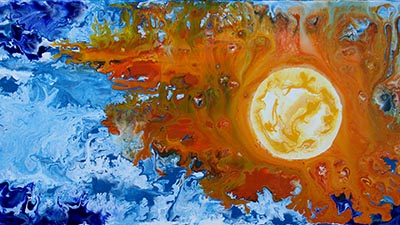
Sun & Moon as Nature Symbols
The sun and moon are the most universal and prominent nature symbols in our world. Images of the sun and moon have graced interior environments since the time of the cave dwellers. The sun and moon have been personified extensively, creating a pantheon of sun and moon gods around the world. Each have their own mythology and unique creation stories.
Symbolism of the Sun
The symbol of the sun brings hope, cheerfulness and optimism. The sun is one of the first things children draw spontaneously. The sun is associated with positivity, clarity, confidence and power. The sun is generally related to masculine energy, growth and higher consciousness.
Meaning of the Sun in the Vedic Tradition
In the early Vedic period, the sun god Surya reigned supreme. In later Hindu periods, only certain sects worship Surya as a central deity. In many branches of Hinduism, Vishnu has largely taken over the role of Surya. In spite of this shift, there are many mantras are dedicated to Surya. Learn more and listen to mantras to the Hindu sun god Surya in the article Surya Mantras.
Symbolism of the Moon
The symbol of the moon is associated with mystery and the hidden side of life. The moon is viewed as a force that establishes a rhythm due to its changing phases. There are numerous moon deities. The moon has sometimes been viewed as masculine though more often it has feminine associations. Moon goddesses may also represent a single phase of the moon.
Other Associations with the Moon
The moon is closely associated with human emotions and the water element. Dreams of the moon are typically related to intuition or that which is secret. This can be a positive association such as hidden talents. The moon can also represent anything which has a strong pull, reflected in the way that the moon affect ocean tides. Learn more about Astrology Mantras.
The Galaxy as the Ultimate Nature Symbol
The galaxy itself represents freedom, expansiveness and endless vistas. These are positive values that can be a daily source of inspiration. As a result, galaxy art and images dramatically shift naturalistic perspective into infinite possibilities.
Constellations and Astronomy
Stars, comets and constellations have been used as powerful nature symbols as far back in history as images have been created. Early civilizations marked time by the movement of the signs in the sky. The importance of this is evidenced by the many megalithic sites with large stone configurations aligned with astronomy all over the earth.
Symbolism of the Stars
We are endlessly fascinated by the stars. Common idioms indicate how much we value the lights of our night sky. A person who is successful in any endeavor is a “star” as well as celebrities of all kinds. In addition, stars have marked the birth of great leaders and the shifting of large epochs. The galaxy is the largest nature symbol imaginable, extending our mental, spiritual and psychological reach into the vastness of space.
Astrea, Goddess of the Stars
The Greek goddess Astrea (or Astraea) is the goddess of justice, innocence, purity and precision. Her name means the “star maiden” or “starry night.” According to legends, Astrea left the earth during the iron Age, ascending to heaven to become the constellation Virgo. One day Astrea will return to earth, bringing with her the Golden Age.
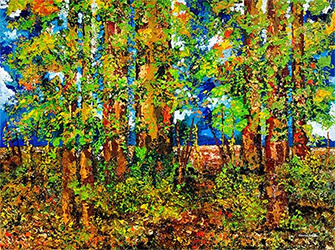
Symbolism of Forests and Trees
Forests have deep-rooted symbolic meaning in virtually every culture on earth. They are viewed as the abode of the nature spirits, especially pixies, trolls and wood elves. Furthermore, they have paradoxical significance: they are both a refuge from danger as well as a source of dangerous wild animals including bears, wolves and mountain lions.
Trees as Nature Symbols
Each tree, in turn, has its own symbolic meaning. For example, oak trees are symbols of strength and endurance. Cedar trees represent healing, cleansing and protection. Apple trees are symbolic of magic, youth, beauty and happiness. See the List of Symbolic Trees below.
Trees in Art and Culture
The deep-rooted symbolism of trees is apparent in common metaphors such as the Tree of Life and our ancestral heritage depicted in family trees. Nature scenes including trees and forests contain multiple mythic and symbolic qualities.
Types of Forests
The types of trees determine the type of forest. They fall into the following major categories: tropical, sub-tropical, Mediterranean, temperate, coniferous and montane. The many types are also designated by their distance from the equator and their altitude.
Economic Significance of Forests
About half of the wood around the world is used for heating homes and other buildings. Forests are so important to the economy around the world that they are usually managed by local or national governments to prevent illegal logging, accidental fires, or other destructive activities. Trees are generally harvested to create fuel and paper.
Preserving Forests
Forests cover about 30% of the earth’s surface. Many individuals are making an effort to use digital documents rather than paper to reduce the need for harvesting trees. The ecosystems of forests are composed of trees, plants, animals, soil, and various microorganisms.
Adaptability of Forests
Trees grow in all types of landscapes including both salt and fresh water areas. In fact, some are located on moving glaciers. Forests themselves are mysterious and constantly changing. As a result, they can provide a lifetime of fascinating study and outdoor adventure.
Wood as a Powerful Nature Symbol
In the Vedic philosophy of the East, wood is viewed as the primal material of the universe. In the Western world, Christians see Christ as the cosmic carpenter. His ultimate sacrifice is represented by a wooden cross. In addition, the Hebrew Kabballah is based on a tree-like structure. Many other examples of the symbolism of trees exist around the world.
Wood in the Five Element System
The five-element system is a powerful way to view the world and the process of transformation. The Chinese five-element system uses wood, fire, earth, metal, and water as the primary natural elements. The wood element is a stimulus for new projects and adventures.
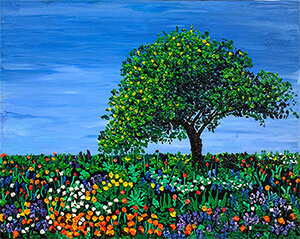
List of Symbolic Trees
Specific trees have their own meanings. The following is a selection of symbolic trees. Additional information is given below for apple trees, aspens and oak trees.
Apple: magic, youth, beauty, happiness
Ash: sacrifice, sensitivity and higher awareness
Aspen: determination, overcoming fears and doubts
Beech: tolerance, past knowledge, softens over criticism
Birch: new beginnings, cleansing of past, vision quests
Cedar: healing, cleansing, protection
Cherry: death and rebirth, new awakenings
Cypress: understanding the role of sacrifice
Elder: birth and death, fairy realm
Elm: strength of will, intuition
Hazel: hidden wisdom, dousing, divination
Heather: healing from within, immortality, initiation
Holly: protection, overcoming of anger, spiritual warrior
Maple: balance, promise, practicality
Oak: strength and courage
Palm: peace and opportunity
Pine: creativity, life, longevity, immortality
Willow: magic, healing, inner vision, dreams
Apple Trees as Nature Symbols
The apple tree is symbolic of magic, youth, beauty and happiness. The energy of blossoms bursting forth in spring and summer encourages us to take on new challenges and renews our strength. The blossoms of apples are pink, a modified red.
Color Meaning of Apple Blossoms
In terms of color symbolism, the color red encourages action, motion, courage and passion. Pink is a more sophisticated color that is often more appealing to adults than pure red. Pink is also gentler and more appropriate for healing. Pink can be used to relieve depression. As the color of warmth and love, pink offers comfort while encouraging motion and an outward orientation.
Apple Blossoms and the Element of Fire
The secondary energy of apple blossoms is the fire energy associated with the pink color. Fire connotes warmth, passion and relationships. Fire creates enthusiasm. Images with a strong fire element are appropriate for supporting romance and idealistic endeavors.
Apples in World Mythology
The apple has long been associated with immortality, as exemplified by its role in the tempting of Adam in the Garden of Eden. In addition, the mystical Isle of Avalon, famed place of eternal rest for Celtic heroes including king Arthur, is literally “the apple land” or “apple island.” In Scandinavian myths, the North-European gods and goddesses were fed an apple every evening by Iduna, the goddess of spring and youth who nurtures an apple orchard in Asgard.
Apple Tree History and Cultivation
The apple has a venerable history. The apple tree is originally a native of Europe and has adapted well to the North American continent. There are over 1,000 varieties of apples cultivated in the United States, all of which are descended from the wild crab apple. Apple trees flower from April to June.
Apple Symbolism in the United States
The apple tree is the state symbol of Washington, known for its prolific apple orchards. The apple blossom is the state flower for Arkansas, once a top apple-producing state in the United States.
Legend of Johnny Appleseed
As far as modern myths and legends go, Johnny Appleseed is the most prominent American legend associated with apples. Born John Chapman in 1774, Johnny Appleseed lived for about 12 years near Pittsburgh, Pennsylvania. In his mid-twenties, Johnny began his journey westward with an eye for providing settlers with apple trees and saplings.
Johnny Appleseed’s Travels and Apple Orchards
There was a law at the time that required settlers to plant 50 apple trees in their first year on newly acquired land. This law was aimed at preventing starvation among the settlers. Although Johnny wandered far and wide planting trees, he also owned and leased considerable areas of land for his apple orchards.
Johnny Appleseed’s Spiritual Life
Johnny was a devout Christian who was influenced by the ideas of Emmanuel Swedenborg. Swedenborg valued love and joy above all other virtues. Compared to many of the repressive philosophies then in vogue, his approach to the spiritual life was basically a breath of fresh air for the settlers with whom Johnny shared his religious tracts and Biblical interpretations.
Johnny’s Influence on American Culture
Johnny Appleseed spent nearly 50 years traversing the wilderness planting apple trees and tending to his own orchards. Johnny dreamed of a landscape beautified by apple blossoms and a country where no one would go hungry. Johnny is reported to have believed that apples are among “the finest things on earth.” Today the American apple industry today is worth billions of dollars. And thanks to Johnny Appleseed and the symbolism of trees, nothing is more American than apple pie!
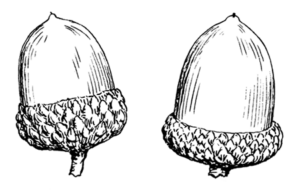
Aspen Meaning and Nature Symbolism
The Greek root of the name “aspen” means “shield.” Aspens are believed to have spiritually protective qualities. Aspen leaves were used in the crowns of heroes. The protective quality of aspens also allowed spirits to go to the underworld and return.
Aspen Tree Characteristics
Individual aspens live about 100 years. However, aspens reproduce by sprouting shoots from their roots. This allows them to grow in a cohesive grove. Renowned for their golden autumn foliage, aspens are the only broadleaf tree in the Rocky Mountains.
Ancient Aspen Groves
An aspen grove is actually a single living organism that can reach several thousand years in age. Even fire damage will not kill a grove of aspens if the roots remain alive. Perhaps this is why aspen trees are symbolic of determination and the overcoming of fears and doubts in the symbolism of trees.
Modern Aspen Distribution
The aspen is the most widely distributed tree in North America and the second most widely distributed in the world. The aspen grows from the Atlantic coast as far south as Virginia up through Alaska and the Arctic Circle. In the western states, aspen lives in the western at higher elevations, usually between 6,500 and 10,000 feet, in high plateaus and alpine areas.
Unique Aspects of Aspen Trees
The characteristic fluttering of aspen tree leaves is one of their most notable attributes. Aspen leaves are flat in cross-section rather than round. This means aspen leaves can twist from side to side or flutter while remaining fairly stable vertically. The shimmering effect that results creates the characteristic aspen “quake.”
More About Aspen Symbolism
Growing Aspen Trees
The bark of aspens contains chlorophyll so that aspens can continue growing even in the winter months. Aspens like cool, dry summers, lots of sun and heavy snow in the winter. Aspens are often found growing in association with pine trees, cottonwood and willow trees.
Aspens as Economic Resources
Aspens are an important source of food and shelter for an estimated five hundred species. The leaves, twigs and bark are favored by deer and elk as well as black bears, cottontails, porcupine, and snowshoe hares, grouse, quail, shrews, mice, and beaver. Aspen are also valuable for paper production.
Aspens Around the World
Although not strong enough for most types of buildings, aspen is sometimes used for barn floors and horse stalls. All in all, aspen trees are amazing plants that add their unique qualities to countless forests across our planet. Remember the symbolism of trees and look for nature’s shimmering beauty next time you take a walk in the great outdoors!
Oak Trees as Nature Symbols
The oak is the mightiest of trees and symbolizes strength and courage. The oak tree was regarded by Socrates as an oracle tree. The Druids likewise ate acorns in preparation for prophesying. In addition, the Druids believed the leaves of the oak tree had the power to heal and renew strength.
Oak Trees and the Romans
The ancient Romans thought oak trees attracted lightening and connected the oak tree to the sky god, Jupiter and his wife, Juno, the goddess of marriage. Thus, the oak was symbolic of conjugal fidelity and fulfillment.
Plants as Nature Symbols
The development of lore around mystical plants has been a natural progression from the ongoing dependence on nature for food, shelter and medicine. From the earliest times, man has relied on the bounty of nature. The powerful forces of nature have been regarded as otherworldly and mysterious, capable of bestowing both tremendous benefit and unspeakable destruction.
Plants as Healers
In his quest to understand and conquer the awesome energies of nature, man has diligently sought to discover the secret powers of plants. And in times of pain and illness, man has instinctively turned to his botanical allies for comfort and healing.
Mystical Plants in Ancient Cultures
The mystical lore of plants crosses virtually every cultural boundary. For example, a 60,000 year old burial site excavated in Iraq included eight different medicinal plants. This evidence of the spiritual significance of plants is echoed around the globe.
Plants in Shamanism
Shamanistic medicine, alive and well in traditional and modern societies today, often incorporates the use of hallucinogenic plants which enable the herbal practitioner to reach unseen realms to obtain higher knowledge and guidance.
Symbolism of Mystical Plants
Many people have also believed that plants themselves possess souls or guardian spirits. As early as the 4th century BC, the Greek philosopher Aristotle attributed a “psyche,” a type of lesser-order soul, to plants. The role of fairies and elemental nature sprits caring for plants also exists in most cultures.
Mystical Plants in the East
In Hinduism, plants are often associated with specific deities. Shiva, the god of health, is sheltered by the bael tree. Learn more about Shiva. Likewise, in Buddhism the bo tree is revered as the primary feature of the site where Gautama Buddha attained his enlightenment. Other Buddhas are specifically dedicated to healing. Read about the Medicine Buddha.
Plants and the Divine Mother
Plants that play a central role in the lives of particular peoples often are given maternal or anthropomorphic identities. For some island dwellers, “Mother Coconut” yields food, oil, rope, clothing fibers and hard shells for a variety of uses. Similarly, the native peoples of the Andes in South America refer to the coca plant as Mama Coca.
Symbolism of Poisonous Plants
Plants have not only been a traditional source of nurturance and blessing, but have alternately been believed to possess evil spirits. Who could doubt that maleficent inhabitants ensouled deadly plants such as belladonna, a key component in witches’ brews and murderous poisons? However, the vast majority of plants have served to soothe, to comfort and to heal.
Symbolic Plants and Nature’s Pharmacy
From the ancient courts of the pharaohs to the aisles of our modern health food stores, the amazing world of herbs and their mythical lore have fascinated mankind. Stories and legends about the secret powers of herbs can be found all over the world, and detailed volumes outlining their specific uses have been treasured by both kings and peasants.
Ancient Plant Formulations
Herbs have been used throughout history for medicinal purposes, to produce cosmetics and to preserve and enhance the quality of food. In ancient times, healing formulas existed for almost every know disease. Specific conditions were treated with a variety of methods such as tinctures, teas, compresses or by inhaling the rejuvenating fragrances of essential oils. Even magic love potions could be obtained by those who desired amorous pleasures.
The Use of Culinary Herbs
Perhaps the most universal use of herbs, past and present, is additions to virtually every type of food. In accordance with Hippocrates’ admonition to “Let food be your medicine,” culinary herbs are used in every culture to prevent spoilage and to increase the digestibility and healing properties of foods.
Herbal Medicine Around the World
Modern science is beginning to rediscover and confirm the healing power of herbs. The story of herbs involves a journey to all of the continents of the world and includes the methods of herbal practitioners such as the ancient apothecaries of Celtic Britain, the medicine men of the American Indians, and the highly skilled herbalists of ancient China.
Herbal Remedies
Natural medicine and herbs are experiencing a global renaissance. For example, nearly 50% of the United States population currently uses alternative therapies of some type. Herbal medicine is foremost among these. Increasing numbers of medical doctors are recognizing the value of herbal medicine. In addition, some of the world’s largest pharmaceutical companies have introduced lines of herbal products.
Nature as Healer
This healing modality is here to stay. The amount of documented research is increasing every day, and pioneering physicians have introduced a variety of herbs to millions of people. Some of the world’s foremost experts in herbology are James A. Duke, Ph.D., Charles Schultz, M.D., and Gary Young, N.D. Their lectures and books have popularized today’s best-selling herbal products and explored in depth the science, power and magic of these herbs.
Powerful Herbal Remedies
From the rain forests of South America to the depths of the world’s oceans, scientists are discovering an increasing number of plants with medicinal properties. Yet we may be just scratching the surface. The vast cornucopia of powerful herbal remedies promoted through mass merchandizing and the glitzy advertising campaigns of the twenty first century bear testimony to man’s inherent belief that the primary source for health and rejuvenation has always been nature’s pharmacy.
Flowers as Nature Symbols
Flowers are among the most ancient objects used for decorative purposes. They are an endless source of inspiration for poetry, stories and myths. Symbolic flowers have been important as far back as we can trace the life of man.
Ancient Records of Flower Symbols
Paleobiologists have found flower fossils dating back 120 million years. In fact, archeologists have uncovered a grave site in a cave in Iraq that included flower remains. Neanderthals of the Pleistocene cave-dwelling epoch appear to have placed bunches of flowers on grave sites. This may indicate that symbolic flowers were part of major rites of passage in the earliest possible social structures.
Flowers and Christian Symbolism
During the Medieval and Early Renaissance Ages from the 13th to the 15th century, flower symbolism and plant symbolism developed as a way of teaching religious truths. For example, the ivy is an evergreen and symbolized eternal life. A peach symbolized truth and salvation and was used in place of the maligned apple of Adam and Eve.
Flower Symbols in Egypt and the East
Symbolic flowers go back millennia in cultures around the world. For example, rose wreaths have been unearthed in ancient Egyptian tombs. In addition, the symbolism of the lotus played an important role in the ancient Egyptian religion. In other cultures, Confucian and Buddhist religious documents contain references to roses.
Symbolic Language of Flowers
The use of flowers to represent emotions was developed to a high degree during Victorian times. Due to the strict protocol of that era, emotions were not openly expressed between men and women. Instead, an elaborate language based on flower symbolism was developed.
The Ocean: Nature’s Symbol of Power
Oceans symbolize the source of life and abundance. Evolutionists believe that all of life originated in the sea. As Walt Whitman wrote in his work Leaves of Grass, the ocean is “the cradle endlessly rocking,” or the birthplace of all life.
Meaning of the Ocean
The ocean is constantly changing. This symbolizes limitless opportunities and possibilities. For this reason, a seascape painting can be advantageous in an office environment. The ocean also represents the emotional world. A seascape can keep us in touch with that part of ourselves as well as with a powerful element in our environment.
Ocean Symbolism in Art
Ocean paintings grace the walls of homes both near and far from the ocean. Ocean paintings are wonderful for those living far from the ocean to remind them of the peace and repetitive sounds and images that have brought tranquility to mankind forever. As for those right on the beach, seascapes are a way to bring the outdoors inside.
Challenges for Artists Depicting the Ocean
The greatest challenge of seascapes is to get the sense of a fluid medium when working with semi-solid paint that dries to a permanently fixed image. The acrylic flow style of painting lends itself well to ocean paintings. The trick is to know the viscosity of the paint and various drying times so that the colors blend esthetically but still give a sense of liquid, fluid movement.
Decorating with Water Symbolism
Decorating with ocean paintings can create a unique and powerful ambiance in any room. The lure of the sea is a cross-cultural phenomenon. Although seascapes and ocean paintings are usually symbolic of serenity, the ocean can also be threatening. Calm seas can become stormy in a matter of moments.
Watch nearly 400 videos on the Vocal Medicine Channel!
Eastern Goddess Ganga Mata
Ganga Mata is a Hindu goddess who personifies the Ganges River. She is a deity associated with forgiveness and purification. Water is a symbol of purity in many spiritual traditions, used for cleansing and baptism. Ganga is depicted riding on a Makara, an animal with the head of a crocodile and the tail of a dolphin. Some theologians believe that the crocodile represents the lower self or the reptilian mind over which Ganga has gained mastery and control.
Water Representing the Emotions
The ocean has also traditionally been symbolic of the feminine side of life. Sailors refer to the sea as a lover or a lady. Water is generally considered to be a symbol of emotions. Water has also been symbolic of the highest good in life and the source of life. Agricultural people worshipped water in the form of rivers, clouds, mist and rain. In the West, water is symbolized by the colors blue, teal and aqua.
Eastern Nature Symbols and Water
In the East, water is symbolized by the colors black and navy blue. Water is also symbolized by the dragon, one of the most ancient and popular of Chinese sacred animals. Rain is often symbolic of tears. Dreams in which water and rain are prominent can mean many things: rejuvenation, cleansing, overwhelming emotions, depression, or fear.
Ship Symbolism in Christianity
Ships are traditional symbols of the Christian church. The symbol may have originated with Noah’s ark, which protected God’s faithful during the flood. In the New Testament, Jesus’ calming of the storm reinforced ships as symbols of safety and refuge. Later Church theologians compared the church as a whole to a ship, and the cross of the crucifixion to the mast of a ship. Incidentally, the central seating area of a cathedral is called the “nave,” which is Latin for “ship.”
Britain and the Meaning of the Sea
The romance of Britain’s sea-history led many artists to devote their entire careers to maritime subjects. Writers also penned innumerable novels and accounts of the heroic deeds of sailors, not to mention the extensive body of lore surrounding pirates.
British Maritime Art
British artists favored pen and ink and watercolor for their maritime subjects. The ever-changing sea seemed best captured in a medium that required the artist to work quickly and accurately. Eventually artists learned to depict the boiling, rolling waves in oil and heavier mediums through layering and the use of opaque highlights.
Nature Symbols and Water Motifs in the East
The divine Mother is associated with the water element in Eastern traditions. This symbolism is sometimes distilled into a downward facing triangle, much like the form of a waterfall that is wider at the top than the bottom. The Mother is the realm of matter. The divine Father is the realm of spirit and fire. The Father is symbolized by an upward pointing triangle much like the form of fire which is wider at the bottom and more narrow at the top of the flames.
Nature Symbols and Water Motifs in the West
Most design motifs associated with water are smooth, flowing patterns. The color blue tends to be connected to asymmetrical, free-form and curved images such as ocean waves or meandering streams. Blue skies are emblematic of optimism and better opportunities.
Water and the Meaning of the Color Blue
The blue of the ocean and the sky are cooling and relaxing, reminding us of the peace and calmness of night. Shores, bays and peninsulas near large bodies of water have a long history as settings for romance, rejuvenation and pondering the mysteries of life.
The Spiritual Meaning of the Ocean
The ocean is often used as a spiritual metaphor. For example, each individual is a drop and the ocean is the All. The infinite depth of the ocean is a common theme in poetry and literature. An ocean painting may be set by the shore or far out on the horizon where unfathomable depths exist. To say that one’s love or rage or devotion is “as deep as the ocean” is to indicate that there is no end to the feeling being experienced.
Ocean Meaning and Danger
The ocean can also be threatening–a wave can develop into a tsunami or a storm can sink a ship. Although the role of the ocean in causing death and havoc is probably not the best topic for an ocean painting, the sense of power in a brewing hurricane can still be attractive and invigorating.
Magnetism of the Ocean
In an ocean painting we usually want to be reminded of a peaceful summer day at the beach. However, the immense power of the ocean is part of its magnetic quality. We can feel the energy driving even the smallest wave in an ocean painting.
Watch nearly 400 videos on the Vocal Medicine Channel!
Best Uses for Ocean Paintings
Seascapes appeal to people of all ages. The ocean is almost as universal as the sky. In addition, an ocean painting is usually a depiction of the surface of the ocean, but what lies beneath is so vast as to be almost inconceivable.
Ocean Paintings in Bedrooms
The most common use of ocean paintings is for bedrooms. The blue colors are peaceful and conducive to sleep and relaxation. They also work well for dining rooms and living rooms. However, large paintings can be overwhelming in a small space.
Ocean Paintings in Apartments
Small to mid-size paintings will be more successful for a small apartment or a small room. A small ocean painting is a study in contrast–the huge, almost immeasurable mass of the ocean contained in a small space in a painting.
Ocean Paintings and Color Symbolism
Seascapes can be used to balance environments with lots of yellows, reds and orange colors. The cool water element helps to balance the more fiery colors. Ocean paintings also help to soften environments with a preponderance of metal in the decor.
Ocean Symbolism in Businesses
The fluidity of the ocean goes without saying. That kind of adaptability is a wonderful metaphor for competing in an ever-changing commercial environment. The almost unlimited forms that can be created and filled by the ocean are an inspiration for businesses finding their niche or reinventing themselves to remain successful in a changing world.
Ocean Paintings in Medical Offices
The fluidity of a water painting can help to offset the harsh edges of metal cabinets and furniture or sterile environments. Ocean paintings are especially useful in doctor’s offices where the relaxation of the patient is paramount and the rooms often have a good deal of white and metallic colors.
Nature Spirits, Mythology and Elemental Beings
Nature spirits exist in nearly every culture on earth. They take the form of both positive helpers and mischievous sprites of all kinds. There is debate about whether these nature spirits possess souls. Marriage to a mortal is believed to grant them a soul, but to shorten their physical lifespan. This article includes the four elemental beings that correspond with the classical Western elements: fire, air, water and earth.
Working with Nature Spirits
Some believe that miracles can be worked through communion with nature spirits. The spirits can be wooed through song and chant, and can also be commanded by mankind since they are in a lower spiritual position on earth. Some adherents believe that even mountains can be ensouled by powerful nature spirits.
Communicating with Nature Spirits
Some individuals claim to possess special abilities to contact and interact with the beings of both the supernatural and the natural worlds. These individuals may have a role similar to traditional shamans. The messages which they receive and the interactions they have with other realms may become guides for others.
Nature Symbols: Elemental Beings of Fire
According to Paracelsus, there are spiritual beings called fiery salamanders that embody the fire element. Paracelsus (1493-1541), a Swiss German physician and alchemist during the German renaissance, believed that nature spirits are associated with the four classical elements: fire, air, water, and earth. Credited as the father of toxicology, Paracelsus was a well-respected scientist who first described nature spirits as a fundamental part of science.
Medieval Theories About Fire Spirits
Other Medieval theorists described the fiery salamander as lizard-shaped and about a foot long. They are purported to glow and to be immune to crawling through fire. Fiery salamanders might be seen in the shape of balls of fire, tongues of fire, or felt through the burning of incense or other combustible materials.
Rulers of the Fire Element
Salamanders are the strongest and most powerful of the four classes of elemental beings. Their ruler is a Djin or jinn, a kind of fiery genie. Without salamanders, all forms of warmth or fire would cease to exist. Salamanders vary in size and appearance. They are usually thought to be long and lean like the flames of fire.
The Origin of Fiery Salamanders
Some think the connection between fire and salamanders is practical: physical salamanders tend to hibernate under rotting logs. When these logs are placed on a fire, the salamanders appear to emerge from the flames. In mystical lore, fiery salamanders are thought to be non-physical beings that control the element of fire.
Salamanders and Destructive Fires
Salamanders can be commanded by humans to assist in increasing or dampening the element of fire as needed. When fiery salamanders are out of control, forest fires and other forms of destruction by fire can occur. Salamanders are an expression of intensity. They are associated with spiritual fire as well as physical ardor. They can be dangerous to humans if not handled or respected properly.
RELATED ARTICLE: Learn about the connection between bluebell flowers and fairies!
Nature Symbols: Sylphs of the Air
Sylphs are mythological creatures referred to as elementals of the air. These elements of the air are sometimes depicted as cloud beings. Sylphs are also associated with angels and may be a part of their origins. Sylphs are often thought to live in high altitudes such as high peaks and mountains. They serve a protective function to preserve the purity of nature. Paracelsus believed that sylphs are “rougher, coarser, taller, and stronger than humans” (from Liber de Nymphis).
Characteristics of Sylphs and Fairies
Paracelsus further described sylphs as expressions of ascendant energy: beautiful and harmonious, sublime, normally invisible, sublime, and highly intellectual. Their eyes are like hawks, possessing the ability to see from great distances. Sylphs can be appealed to in all situations where wind has gotten out of control. They are burdened by air pollution and avoid places with contaminated air.
The Connection Between Sylphs and Fairies
Others believe that sylphs are a branch of the sidhe, a metaphysical race known in ancient Ireland and comparable to fairies, elves, leprechauns, and the like. Their association with the air gives them the ability to control the weather. Although they resemble humans, they also have a pair of huge, feathered wings on their backs. Sylphs are thought to rule the world of dreams.
The Evolution of Fairies
The oldest written records of fairies were from Gervase of Tilbury in the 13th century. Fairies were not always beautiful to look at or possessed of elevated personalities. Some thought that they were somewhere between the realm of angels and devils. Many types of magical creatures were labelled as fairies.
The Magic of Fairies
Fairies were not always thought to have wings like sylphs. They were originally believed to fly through pure magic. Tiny fairies associated with gardens and flower have appeared in artwork for centuries, but less often in folklore.
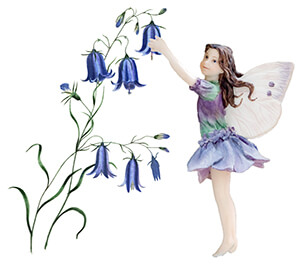
Author’s Story About Fairies
My mother is particularly devoted to visiting ancient sacred sites. One time they were far off the road in a farmer’s field at the location of a small dolmen. My grandparents (from the Irish side) were traveling with them, and they decided to have a picnic at the site.
My mother heard the fairies singing while they were there, but did not say anything to the others who were less inclined to such things. When they’d finished eating, they got back in the car.
Suddenly my grandmother turned to my mom and said, “Where were the school children that I heard singing?” My mother said, “Oh! You heard them, too!” As far as my mother was concerned, that confirmed the presence of the fairies!
Nature Symbols: The Water Element
Water has the ability to change effortlessly without ever losing its essential character. In the five element system used in Chinese medicine, personalities can be classified by natural elements. If your predominant compatibility is with water, you are resourceful, dependable and single-minded in the pursuit of your goals. You have a strong sense of self and follow your path with purpose in spite of difficult or demanding situations. Learn more in Mantras and the Five Elements.
Playful Water Undines
Undines are the spirits of water, sometimes referred to as nymphs. Undines can live in both fresh and salt water. They love to play in the spray of waterfalls and in mountain streams. They closely resemble humans in size but may also be smaller depending on the body of water that they inhabit. The name “undine” comes from the Latin word “unda” meaning wave or water. Some view mermaids as a kind of undine of the ocean.
Undines and the Emotions
Water represents the emotions. In the case of undines, they are believed to possess a refined nature that exemplifies love, beauty and grace. Undines are usually depicted as female, just as gnomes (see below) are usually shown as male, even though both of these types of nature spirits exist in male and female form.
Relationships Between Humans and Undines
Relationships between nature spirits and humans are also legendary. These are usually between a female undine and a male human. For example, a romance book written by Friedrich de la Motte in 1811 was the inspiration for the modern tale of The Little Mermaid.
Mermaids in Myths and Legends
Mermaids have figured in myths and legends for just about forever! They have been associated with sea goddesses including Calypso, Amphritrites, Thethys and Ran (Norse). They are also associated with love goddesses like Aphrodite and Venus. According to Beatrice Phillpotts in her book Mermaids, these mythical creatures beckon to the adventurous and promise both risk and forbidden desires.
Mermaid Symbolism
Mermaids symbolize love, beauty, mystery, allure, sensuality, untamed femininity, persuasion and perception. Mermaids are often shown holding a comb made of fish bone. The fish bone is an ancient nautical symbol of control over the sea and nature. Other mermaids are shown holding a mirror, a symbol of their somewhat narcissistic personalities.
Mermaids in Ancient Cultures
Mermaids appear in every culture on earth. The first recorded half-fish, half-human creature is Oannes, a Babylonian God from the 4th century BC. In Germany mermaids are called Meriminni, in Iceland they are Marmenill, in Holland they are Maremind, in Ireland they are Merow and so forth. Mermaids also figure in eastern lore in both India and China. Mermaids are elusive, only appearing in the light of moon between dawn and dusk and only to the true of heart. These are magical times when sight and perception are malleable.
The Danger of Sirens
Sirens are powerful sea-dwelling mermaids that are both fascinating and dangerous. Sirens figure in Greek mythology as beguiling creatures with voices so sweet that they lure sailors into destroying their ships upon the shore or rocks. They are said to entice mortal lovers to follow them beneath the sea.
Mermaids in Nature and Myth
Mermaids can also be likened to the undines, an elemental spirit said to inhabit all types of water and to ensoul this aspect of nature. Undines are one of four types of elementals. The others are the fiery salamanders (fire elementals), sylphs (wind elementals), and gnomes (earth elementals).
Mermaids and Manatees
Some historians believe that mermaids are the fictionalized versions of manatees. In fact, the scientific name for manatees is Sirenia. Manatees are large, slow-moving sea cows with little real resemblance to the fabled mermaids. Christopher Columbus is credited with the first modern sighting of a manatee during his 1492 voyage across the Atlantic Ocean.
Mermaids in Modern Culture
Mermaids and mermen continue to figure in modern literature and movies, including the lake-dwelling merpeople in the Harry Potter series and Disney’s Little Mermaid. In addition, mermaids call to us from almost every corner in urban America as the emblem of Starbucks.
Water as a Nature Symbol in Artwork
Water paintings alternately soothe and calm us or excite us with the reminder of fun, holidays and leisure time. Water paintings help to balance environments with lots of fire elements such as red, yellow and orange colors. Water paintings can serve a similar purpose to other water features in interior design: fountains, fish tanks, indoor ponds and waterfalls. Water paintings are perfect for bedrooms, dining rooms and places where you want to relax and recuperate.
The Fire Element and Water Symbolism
Another aspect of ocean paintings is in the non-physical realm. Sunshine on water brings in the secondary element of fire. Sunshine on water is one of the greatest visual thrills available in nature. Sunshine on water has been the subject of poems, songs, photography and artwork as far back as recorded history.
Sunshine on Water Meaning
References to sunshine on water in literature are also quite powerful and have been including in the literature of many cultures. References to sunshine on water can also be included in more generic inspirational quotes: Laughter is like the sunshine that sparkles upon water. Sunshine on water is endlessly entrancing.
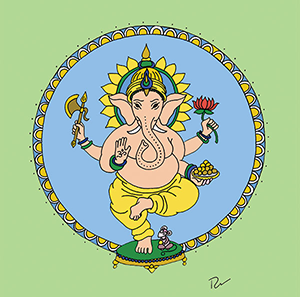
Nature Symbols: Gnomes of the Earth
Gnomes are earth dwellers who often work with minerals, stones, flowers, greenery, gems, and metals. They are said to be the guardians of hidden treasures. Gnomes are also said to be caretakers of shrubs, trees, gardens, and fields. Gnomes are healers of the earth and of humans. For example, gnomes are thought to help help mend broken bones.
The Origin of Gnomes
The name “gnome” is possibly derived from the Greek word “genomus” meaning an “earth dweller.” Some gnomes are believed to live in caves beneath the surface of the earth. The appearance of gnomes may change based on the part of the earth that they tend. Gnomes caring for poisonous shrubs, for example, may be small and ugly. Those caring for large, beautiful trees may be much larger and more attractive. Typically, gnomes are smaller than humans.
The Personality of Gnomes
The personality of gnomes also varies widely. They may be friendly or malicious. However, even the treacherous ones will be helpful once they have been befriended. Female gnomes are called gnomides. Elves are a common alternate form of gnomes. Elves may live in houses or barns rather than in direct contact with the earth. All forms of gnomes are purported to be both stubborn and brave. In their best forms, their deepest desire is to transform the physical world and nature into something of great value and beauty.
Nature Symbols & the Science of Sound
The mastery of mantras can also connect you to your environment and the power of nature. There are many indigenous traditions of singing to the wind, the rain and the earth. You can begin to work with natural elements and the weather. Many indigenous traditions hold that all of life has some level of consciousness and sentience.
Author’s Story of the Pink Waterfall
I had a remarkable experience a few years ago chanting in nature. Most people do not realize that there are megaliths here in Montana. Megaliths are large stones structures of various types akin to the more famous Stonehenge in Britain. A number of these megaliths are located about a ninety minute drive from my home in Bozeman.
Touring the Montana Megaliths
My husband Andrew and I took a day-long tour of some of the megaliths with Julie Ryder, an avid researcher and expert on the topic. When our group had finished a fascinating day exploring the megaliths with Julie, I was standing near a unique structure called the Pink Vault.
The Pink Vault
The Pink Vault consists of two large pink granite boulders surrounded by a wall of black granite boulders. I found the structure to be particularly fascinating and attractive. Julie saw me from across a little valley and called over to me to sing a mantra.
Chanting a Mantra
I started a mantra to Lalita, a Hindu goddess. My husband knew the song and began chanting with me. After a few minutes we rejoined the group. Julie had filmed us chanting and thought she had turned off the camera.
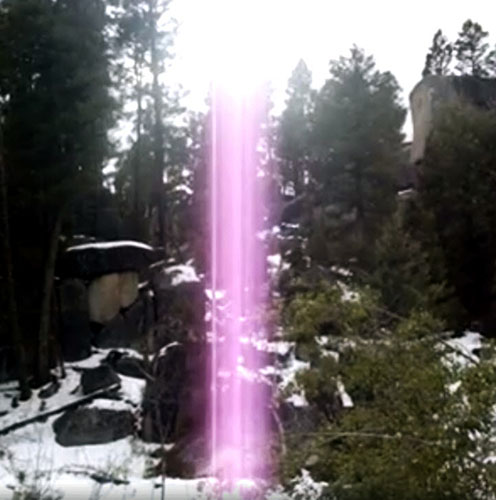
An Accidental Video
The next morning she discovered that the camera had actually been on for a few minutes after we had been chanting near the Pink Vault. She had captured an image of a waterfall of pink light cascading down in that spot. The image above is a still from that original video.
Reaching Unseen Dimensions
For me, this experience was a sign that the chanting was having an energetic impact in unseen dimensions. I find the memory of that pink waterfall to be comforting on days when I may not feel that my chants are making a difference for me or in the world at large. Something certainly seemed to be happening!
Author Kathleen Karlsen
Kathleen Karlsen is a musician, artist, writer and speaker. She is the author of two books (Flower Symbols and Vocal Medicine) and over 200 articles. Kathleen, her husband Andrew, and their five children live in Bozeman, Montana. More about Kathleen Karlsen.



